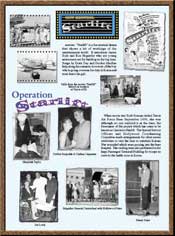|
|
General J.H. Doolittle
Tokyo Raiders Reunion, 2003
|
|
“The Korean War: Operation Starlift”


Frances Faye entertains Korean War wounded as a part of Operation Starlift
When the movie star Ruth Roman visited Travis Air Force Base in September 1950, she was, although no one realized it at the time, the forerunner of the project which has come to be known as Operation Starlift. The Special Service Officers and Hollywood Coordinating Committee made arrangements for other screen celebrities to visit the base to entertain Korean War wounded which were pouring into base hospitals here and in Japan. The visiting stars also performed in the large Passenger Terminal Building for troops en route to the battle zone in Korea.

Starlift Stars
Helmeted, rifle-carrying soldiers and marines, sailors and airmen relaxed for a few moments and forgot momentarily that they would soon be on their way to combat. Sometimes the loud speaker would boom out, notifying the men that their plane was ready to load. They would file out slowly, looking back over their shoulders at the performers, calling out: “Goodbye, thanks, thanks a lot.” And the performer would reply: “Goodbye boys, take care of yourselves. God bless you.”
In the hospital wards, men who had fallen in battle only a few days before looked up in surprise as a familiar face and figure walked up to their bedsides and said: “Hiya boy, how are you doing?” Jane Russell, Shirley Temple, Shelley Winters, Alan Ladd, Jack Benny, Danny Kaye, Pat O’Brien, Claudette Colbert, Keenan Wynn, Donald O’Connor, Janet Leigh, Vic Damone, Debbie Reynolds, Yvonne De Carlo, Bob Hope, and many others visited Travis to give their time and talent to entertain the personnel here.

Doris Day
The project remained without a name until one day in late September 1950 when Brigadier General Joe W. Kelly, then base commander, walked into the Public Information Office and asked: “Who is coming here from Hollywood this week on our “Operation Starlift?” The phrase, which so aptly described the project, immediately caught on and became the quasi-official name for the regularly scheduled flights which flew these entertainers to the air base from Burbank every Saturday and returned them the following day.

Even the heavy weight champion boxer stopped in for a visit
Appearing voluntarily, these stars worked harder while at the base than when they were emoting before the cameras. It was a rule, not the exception, for these highly-salaried celebrities to stage two or three hour-long shows at the Passenger Terminal Building for servicemen awaiting air transportation overseas, and then giving a performance at the hospital auditorium for the ambulatory patients.
“There is no better medicine for these men,” one doctor was heard to remark, “than a visit from these people whom they have seen so often on the screen but never thought to meet in person. All of them have been to the movies and to them it means the United States when they see the stars that they enjoyed seeing in motion pictures. It means they are home again.”
The motion picture “Starlift” was made at the base by Warner Brothers studios and was based on Travis’ Operation Starlift.
Extensive coverage of “Operation Starlift” is available at the Travis Air Museum’s Korean War exhibit and in the Travis Air Museum News from December 2000.
The following photographic collage is available for download as a PDF document.
Click on the image or click here to download.

|
|